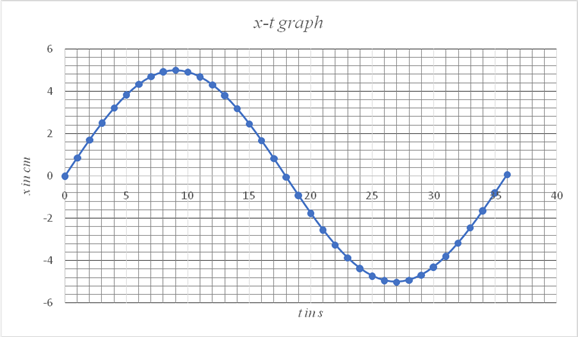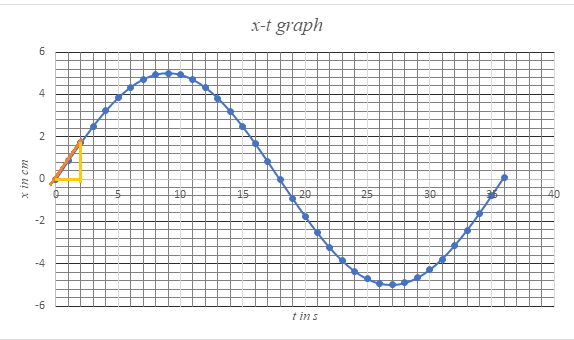
Concept explainers
(a)
To plot:The position x of a body oscillating on a spring as a function of time.
(a)
Explanation of Solution
Given:
The equation of position x as a function of time
The values of the constants
The time interval
Calculation:
Using the given values of the variables in the given equation,
On a spreadsheet calculate the values of the position with respect to time and plot a graph as shown.
| t in s | x in cm |
| 0 | 0 |
| 1 | 0.87054 |
| 2 | 1.71449 |
| 3 | 2.50607 |
| 4 | 3.22109 |
| 5 | 3.83772 |
| 6 | 4.33712 |
| 7 | 4.70403 |
| 8 | 4.92725 |
| 9 | 4.99996 |
| 10 | 4.91993 |
| 11 | 4.68961 |
| 12 | 4.31605 |
| 13 | 3.81064 |
| 14 | 3.18882 |
| 15 | 2.4696 |
| 16 | 1.67494 |
| 17 | 0.82912 |
| 18 | -0.042 |
| 19 | -0.9119 |
| 20 | -1.7539 |
| 21 | -2.5424 |
| 22 | -3.2531 |
| 23 | -3.8645 |
| 24 | -4.3579 |
| 25 | -4.7181 |
| 26 | -4.9342 |
| 27 | -4.9996 |
| 28 | -4.9123 |
| 29 | -4.6749 |
| 30 | -4.2947 |
| 31 | -3.7833 |
| 32 | -3.1563 |
| 33 | -2.433 |
| 34 | -1.6353 |
| 35 | -0.7876 |
| 36 | 0.08407 |

Figure 1
Conclusion:
Thus, the position x of the object which undergoes oscillation following the equation
(b)
To measure:The slope of the
(b)
Answer to Problem 114P
The velocity of the object at time
Explanation of Solution
Given:
The
Calculation:
Draw a tangent to the curve at time

Figure 2
From Figure 2, the slope of the tangent (drawn in red) is given by,
Hence the velocity of the object at time
Conclusion:
Thus, the velocity of the object at time
(c)
To calculate:The average velocity for a series of intervals starting from
(c)
Answer to Problem 114P
The average velocities for the time intervals starting at
Explanation of Solution
Given:
The equation for the position of the oscillating particle
The times at which the average velocity is determined
Formula used:
The average velocity of a particle is the rate of change of position of the object during the time interval.
Calculation:
Determine the value of the position of the object
Determine the position of the particle at time
Determine the average velocity for the time interval
Find the position of the particle at time
Determine the average velocity for the time interval
Find the position of the particle at time
Determine the average velocity for the time interval
Find the position of the particle at time
Determine the average velocity for the time interval
Find the position of the particle at time
Determine the average velocity for the time interval
Find the position of the particle at time
Determine the average velocity for the time interval
Conclusion:
Thus, the average velocities for the time intervals starting at
(d)
To compute:
(d)
Answer to Problem 114P
The value of
Explanation of Solution
Given:
The equation for the position of the oscillating particle
Formula used:
The velocity of a particle is the first derivative of the position with respect to time and is given by,
Calculation:
Differentiate the given equation with respect to time.
Substitute
Conclusion:
The value of
(e)
To compare: the results of parts (c) and (d) and explain why the part(c) results approach part (d) result.
(e)
Explanation of Solution
Given:
Results of part (c)
The average velocities of the particle for the time intervals starting at
are as follows:
| Time interval(s) | Average velocity (cm/s) |
| 0-6.0 | 0.72 |
| 0-3.0 | 0.86 |
| 0-2.0 | 0.86 |
| 0-1.0 | 0.87 |
| 0-0.50 | 0.87 |
| 0.25 | 0.87 |
Results of part (d)
The instantaneous velocity of the particle at time
Introduction:
Average velocity is defined as the ratio of change in position to the time interval.
The instantaneous velocity is given by,
As the measured time interval becomes smaller, the average velocity approaches the instantaneous velocity. For a large time interval such as
Conclusion:
Thus, it can be seen that as th magnitude of the measured time intervals decrease, the values of the average velocities approach the value of instantaneous velocity.
Want to see more full solutions like this?
Chapter 2 Solutions
Physics for Scientists and Engineers
- A landscape architect is planning an artificial waterfall in a city park. Water flowing at 1.70 m/s will leave the end of a horizontal channel at the top of a vertical wall h = 2.35 m high, and from there it will fall into a pool (Fig. P3.42). (a) Will the space behind the waterfall be wide enough for a pedestrian walkway? (b) To sell her plan to the city council, the architect wants to build a model to standard scale, which is one-twelfth actual size. How fast should the water flow in the channel in the model? Figure P3.42arrow_forwardA student at the top of a building of height h throws one ball upward with a speed of vi and then throws a second ball downward with the same initial speed vi. Just before it reaches the ground, is the final speed of the ball thrown upward (a) larger, (b) smaller, or (c) the same in magnitude, compared with the final speed of the ball thrown downward?arrow_forwardIf , and , find the unknown constants a and b such that .arrow_forward
- A particle moves in xy plane with a constant acceleration. At t = 0 the particle at r = (4.0m)ỉ + (3.0m)j, with velocity Vo. At t = 2.0s the particle has moved to r = (10.0m)ï – (2.0m)j and its velocity has changed to v; = (5.0")i- (6.0")j. a) Find the initial velocity of the particle vo. b) What is the acceleration of the particle ã? c) What is the velocity of the particle as a function of time i(t)? d) What is the position vector of the particle as a function of time 7(t)?arrow_forwardThe velocity in ft/s of an object moving along a line is given byv = ƒ(t) on the interval 0 ≤ t ≤ 6 (see figure), where t ismeasured in seconds.a. Divide the interval [0, 6] into n = 3 subintervals, [0, 2], [2, 4],and [4, 6]. On each subinterval, assume the object moves at aconstant velocity equal to the value of v evaluated at the leftendpoint of the subinterval, and use these approximations toestimate the displacement of the object on [0, 6] b. Repeat part (a) for n = 6 subintervalsarrow_forwardA particle starts moving with the initial velocity v(0) = 1 and accelerates as a(t) = sin t + t for t > 0. (a) Find the velocity function for the particle. (b) What would be its velocity at time t = 5?arrow_forward
- A position-time graph for a particle moving along the x axis is shown in the figure below. х (m) 12A 10 8 4 t (s) 1 2 3 4 5 6 (a) Find the average velocity in the time interval t = 2.00 s to t = 3.50 s. (Indicate the direction with the sign of your answer.) m/s (b) Determine the instantaneous velocity at t = 2.00 s by measuring the slope of the tangent line shown in the graph. (Note that t = 2.00 s is where the tangent line touches the curve. Indicate the direction with the sign of your answer.) m/s (c) At what value of t is the velocity zero?arrow_forwardEarthquakes produce several types of shock waves. The most well known are the P-waves (P for primary or pressure) and the S-waves (S for secondary or shear). In the earth’s crust, P-waves travel at about 6.5 km>s and S-waves move at about 3.5 km/s. The time delay between the arrival of these two waves at a seismic recording station tells geologists how far away an earthquake occurred. If the time delay is 33 s, how far from the seismic station did the earthquake occur?arrow_forwardP1. (a) A particle moves along the path whose equation is r= 2 m. If the angle 0 =r- 2t rad, determine the velocity and acceleration of the particle when 6 is 3 rad. (b) The x and y components of the displacement in meters of a point are given by the equations x = =r. Determine the velocity and acceleration of the point when t 1 s. (c) A particle moves along the path whose equation is s = when t= 1 s and radius of curvature p of the point is 10 m. 5r and y 5r m. Determine the velocity and accelerationarrow_forward
- Your answer is partially correct. A particle leaves the origin with an initial velocity = (2.54î) m/s and a constant acceleration a ( − 4.67î – 1.95ĵ) m/s². When the particle reaches its maximum x coordinate, what are (a) its velocity, (b) its position vector? (a) Number -1.07 (b) Number Save for Later i î+ Ĵ Units i m/s Ĵ Unitsarrow_forwardA point moving a long a curve whose position vector is R(t)=(t sin t +cost)i+(sin t-t cost)j+4 k; the normal component of acceleration is : 1+tarrow_forwardA particle moves along the x-axis according to x(t) = 8t - 2t^2 m. (a) what is the instantaneous velocity at t = 2 s and t = 3 s? (b) what is the instantaneous speed at these times? (c) what is the average velocity between t = 2 s and t = 3 s?arrow_forward
 Principles of Physics: A Calculus-Based TextPhysicsISBN:9781133104261Author:Raymond A. Serway, John W. JewettPublisher:Cengage Learning
Principles of Physics: A Calculus-Based TextPhysicsISBN:9781133104261Author:Raymond A. Serway, John W. JewettPublisher:Cengage Learning Glencoe Physics: Principles and Problems, Student...PhysicsISBN:9780078807213Author:Paul W. ZitzewitzPublisher:Glencoe/McGraw-Hill
Glencoe Physics: Principles and Problems, Student...PhysicsISBN:9780078807213Author:Paul W. ZitzewitzPublisher:Glencoe/McGraw-Hill University Physics Volume 1PhysicsISBN:9781938168277Author:William Moebs, Samuel J. Ling, Jeff SannyPublisher:OpenStax - Rice University
University Physics Volume 1PhysicsISBN:9781938168277Author:William Moebs, Samuel J. Ling, Jeff SannyPublisher:OpenStax - Rice University


